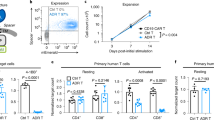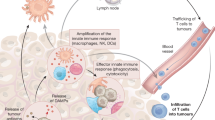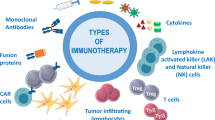Abstract
Relapses after autologous stem cell transplants for hematopoietic malignancies are frequent and post-transplant infections continue to cause significant post-transplant morbidity and even mortality. The post-transplant period is typically characterized by low lymphocyte counts and impaired immune cell function. Early restoration of immune function may contribute to better disease control and enhance protection from infections. Indeed the attainment of a ‘minimal residual disease’ status following high-dose therapy makes the early post-transplant period ideal for the introduction of antitumor immunotherapy. Attempts to generate immunity against tumor and microbial antigens after autotransplantation have included vaccinations, T cell infusions (both resting and activated) and combinations of vaccinations and adoptive T cell infusions. One successful strategy for generating robust immune responses against microbial antigens was the combination of pre and post-transplant immunizations along with an early (post-transplant) infusion of in vivo vaccine-primed and ex vivo co-stimulated autologous T cells. Whether this or similar strategies will lead to the generation of effective antitumor immunity is unknown. The lessons gained from efforts to rebuild immune system function in the setting of autotransplantation may also be applicable to the problem of restoring immunity in other immunodeficient groups such as patients with cancer or HIV disease and the elderly.
This is a preview of subscription content, access via your institution
Access options
Subscribe to this journal
Receive 12 print issues and online access
$259.00 per year
only $21.58 per issue
Buy this article
- Purchase on Springer Link
- Instant access to full article PDF
Prices may be subject to local taxes which are calculated during checkout
Similar content being viewed by others
References
Philip T, Guglielmi C, Hagenbeek A, Somers R, Van der Lelie H, Bron D et al. Autologous bone marrow transplantation as compared with salvage chemotherapy in relapses of chemotherapy-sensitive non-Hodgkin's lymphoma. New Engl J Med 1995; 333: 1540–1545.
Rapoport AP, Rowe JM, Kouides PA, Duerst RA, Abboud CN, Liesveld JL et al. One hundred auto-transplants for relapsed or refractory Hodgkin's disease and lymphoma: value of pretransplant disease status for predicting outcome. J Clin Oncol 1993; 11: 2351–2361.
Linch DC, Winfield D, Goldstone AH, Moir D, Hancock B, McMillan A et al. Dose intensification with autologous bone marrow transplantation in relapsed and resistant Hodgkin's disease: result of a BNLI randomized trial. Lancet 1993; 341: 1051–1054.
Barlogie B, Jagannath S, Vesole DH, Nauckes S, Cheson B, Mattox S et al. Superiority of tandem autologous transplantation over standard therapy for previously untreated multiple myeloma. Blood 1997; 89: 789–793.
Attal M, Harousseau JL, Stoppa AM, Sotto JJ, Fuzibet JG, Rossi JF et al. A prospective, randomized trial of autologous bone marrow transplantation and chemotherapy in multiple myeloma. Intergroupe Francais du Myelome. N Engl J Med 1996; 335: 91–97.
Child JA, Morgan GJ, Davies FE, Owen RG, Bell SE, Hawkins K et al. High-dose chemotherapy with hematopoietic stem-cell rescue for multiple myeloma. N Engl J Med 2003; 348: 1875–1883.
Borrello I, Sotomayor EM, Rattis FM, Cooke SK, Gu L, Levitsky HI et al. Sustaining the graft-versus-tumor effect through posttransplant immunization with granulocyte-macrophage colony-stimulating factor (GM-CSF)-producing tumor vaccines. Blood 2000; 95: 3011–3019.
Teshima T, Mach N, Hill GR, Pan L, Gillessen S, Dranoff G et al. Tumor cell vaccine elicits potent antitumor immunity after allogeneic T cell-depleted bone marrow transplantation. Cancer Res 2001; 61: 162–171.
Overwijk WW, Theoret MR, Finkelstein SE, Surman DR, de Jong LA, Vyth-Dreese FA et al. Tumor regression and autoimmunity after reversal of a functionally tolerant state of self-reactive CD8+ T cells. J Exp Med 2003; 198: 569–580.
Hoyle C, Goldman JM . Life-threatening infections occurring more than 3 months after BMT. Bone Marrow Transplant 1994; 14: 247–252.
Ketterer N, Espinouse D, Chomarat M, Dumontet C, Moullet I, Rieux C et al. Infections following peripheral blood progenitor cell transplantation for lymphoproliferative malignancies: etiology and potential risk factors. Am J Med 1999; 106: 191–197.
Dykewicz CA . Summary of the guidelines for preventing opportunistic infections among hematopoietic stem cell transplant recipients. Clin Infect Dis 2001; 33: 139–144.
Guinan EC, Molrine DC, Antin JH, Lee MC, Weinstein HJ, Sallan SE et al. Polysaccharide conjugate vaccine responses in bone marrow transplant patients. Transplantation 1994; 57: 677–684.
Mackall CL, Fleisher TA, Brown MR, Andrich MP, Chen CC, Feuerstein IM et al. Distinctions between CD8+ and CD4+ T cell regenerative pathways result in prolonged T cell subset imbalance after intensive chemotherapy. Blood 1997; 89: 3700–3707.
Hakim FT, Cepeda R, Kaimei S, Mackall CL, McAtee N, Zujewski J et al. Constraints on CD4 recovery postchemotherapy in adults: thymic insufficiency and apoptotic decline of expanded peripheral CD4 cells. Blood 1997; 90: 3789–3798.
Mackall CL, Stein D, Fleisher TA, Brown MR, Hakim FT, Bare CV et al. Prolonged CD4 depletion after sequential autologous peripheral blood progenitor cell infusions in children and young adults. Blood 2000; 96: 754–762.
Avigan D, Wu Z, Joyce R, Elias A, Richardson P, McDermott D et al. Immune reconstitution following high-dose chemotherapy with stem cell rescue in patients with advanced breast cancer. Bone Marrow Transplant 2000; 26: 169–176.
Sportès C, McCarthy NJ, Hakim F, Steinberg SM, Liewehr DJ, Weng D et al. Establishing a platform for immunotherapy: clinical outcome and study of immune reconstitution after high-dose chemotherapy with progenitor cell support in breast cancer patients. Biol of Blood Marrow Transplant 2005; 11: 472–483.
Machatschek J, Duda J, Matthay K, Cowan M, Horn B . Immune reconstitution, infectious complications and post transplant supportive care measures after autologous blood and marrow transplantation in children. Bone Marrow Transplant 2003; 32: 687–693.
Rutella S, Rumi C, Laurenti L, Pierelli L, Sora F, Sica S et al. Immune reconstitution after transplantation of autologous peripheral CD34+ cells: analysis of predictive factors and comparison with unselected progenitor transplants. Br J Haematol 2000; 108: 105–115.
Small TN, Papadopoulos EB, Boulad F, Black P, Castro-Malaspina H, Childs BH et al. Comparison of immune reconstitution after unrelated and related T cell-depleted bone marrow transplantation: effect of patient age and donor leukocyte infusions. Blood 1999; 93: 467–480.
Nordoy T, Husebekk A, Aaberge IS, Jenum PA, Samdal HH, Flugsrud LB et al. Humoral immunity to viral and bacterial antigens in lymphoma patients 4–10 years after high-dose therapy with ABMT. Serological responses to revaccinations according to EBMT guidelines. Bone Marrow Transplant 2001; 28: 681–687.
Fry TJ, Mackall CL . The many faces of IL-7: from lymphopoiesis to peripheral T cell maintenance. J Immunol 2005; 174: 6571–6576.
Hakim FT, Memon SA, Cepeda R, Jones EC, Chow CK, Kasten-Sportès C et al. Age-dependent incidence, time course, and consequences of thymic renewal in adults. J Clin Invest 2005; 115: 930–939.
Fassas ABT, Bolaños-Meade J, Buddharaju LN, Rapoport AP, Cottler-Fox M, Chen T et al. Cytomegalovirus infection and non-neutropenic fever after autologous stem cell transplantation: high rates of reactivation in patients with multiple myeloma and lymphoma. Br J Haematol 2001; 112: 237–241.
Porrata LF, Gertz MA, Inwards DJ, Litzow MR, Lacey MQ, Tefferi A et al. Early lymphocyte recovery predicts superior survival after autologous hematopoietic stem cell transplantation in multiple myeloma or non-Hodgkin's lymphoma. Blood 2001; 98: 579–585.
Porrata LF, Markovic SN . Timely reconstitution of immune competence affects clinical outcome following autologous stem cell transplantation. Clin Exp Med 2004; 4: 78–85.
Gandhi MK, Egner W, Sizer L, Inman I, Zambon M, Craig JIO et al. Antibody responses to vaccinations given within the first two years after transplant are similar between autologous peripheral blood stem cell and bone marrow transplant recipients. Bone Marrow Transplant 2001; 28: 775–781.
Antin J, Guinan EC, Avigan D, Soiffer RJ, Joyce RM, Martin VJ et al. Protective antibody responses to pneumococcal conjugate vaccine after autologous hematopoietic stem cell transplantation. Biol Blood Marrow Transplant 2005; 11: 213–222.
Chan CY, Molrine DC, Antin JH, Wheeler C, Guinan EC, Weinstein HJ et al. Antibody responses to tetanus toxoid and haemophilus influenzae type b conjugate vaccines following autologous peripheral blood stem cell transplantation (PBSCT). Bone Marrow Transplant 1997; 20: 33–38.
Hata A, Asanuma H, Rinki M, Sharp M, Wong RM, Blume K et al. Use of inactivated varicella vaccine in recipients of hematopoietic-cell transplants. N Engl J Med 2002; 347: 26–34.
Black S, Shinefield H, Fireman B, Lewis E, Ray P, Hansen JR et al. Efficacy, safety and immunogenicity of heptavalent pneumococcal conjugate vaccine in children. Pediatr Infect Dis J 2000; 19: 187–195.
Mapara MY, Sykes M . Tolerance and cancer: mechanisms of tumor evasion and strategies for breaking tolerance. J Clin Oncol 2004; 22: 1136–1151.
Reichardt VL, Okada CY, Liso A, Benike CJ, Stockerl-Goldstein KE, Engleman EG et al. Idiotype vaccination using dendritic cells after autologous peripheral blood stem cell transplantation for multiple myeloma-a feasibility study. Blood 1999; 93: 2411–2419.
Coscia M, Mariani S, Battaglio S, Di Bello C, Fiore F, Foglietta M et al. Long-term follow-up of idiotype vaccination in human myeloma as a maintenance therapy after high-dose chemotherapy. Leukemia 2004; 18: 139–145.
Davis TA, Hsu FJ, Caspar CB, van Beckhoven A, Czerwinsk DK, Liles TM et al. Idiotype vaccination following ABMT can stimulate specific anti-idiotype immune responses in patients with B-cell lymphoma. Biol Blood Marrow Transplant 2001; 28: 775–781.
Holmberg LA, Oparin DV, Gooley T, Lilleby K, Bensinger W, Reddish MA et al. Clinical outcome of breast and ovarian cancer patients treated with high-dose chemotherapy, autologous stem cell rescue and THERATOPE® STn-KLH cancer vaccine. Bone Marrow Transplant 2000; 25: 1233–1241.
Reece DE, Foon KA, Bhattacharya-Chatterjee M, Hale GA, Howard DS, Munn RK et al. Use of the anti-idiotype antibody vaccine TriAb after autologous stem cell transplantation in patients with metastatic breast cancer. Bone Marrow Transplant 2000; 26: 729–735.
Miller JS, Curtsinger J, Berthold M, Malvey K, Bliss RL, Le CT et al. Diminished neo-antigen response to keyhole limpet hemocyanin (KLH) vaccines in patients after treatment with chemotherapy or hematopoietic cell transplantation. Clin Immunol 2005; 117: 144–151.
Brossart P, Heinrich KS, Stuhler G, Behnke L, Reichardt VL, Stevanovic S et al. Identification of HLA-A2-restricted T cell epitopes derived from the MUC1 tumor antigen for broadly applicable vaccine therapies. Blood 1999; 93: 4309–4317.
Jalili A, Ozaki S, Hara T, Shibata H, Hashimoto T, Abe M et al. Induction of HM1.24 peptide-specific cytotoxic T lymphocytes by using peripheral blood stem cell harvests in patients with multiple myeloma. Blood 2005; 106: 3538–3545.
van Rhee F, Szmania SM, Zhan F, Gupta SK, Pomtree M, Lin P et al. NY-ESO-1 is highly expressed in poor-prognosis multiple myeloma and induces spontaneous humoral and cellular immune responses. Blood 2005; 105: 3939–3944.
Raje N, Hideshima T, Davies FE, Chauhan D, Treon SP, Young G et al. Tumour cell/dendritic cell fusions as a vaccination strategy for multiple myeloma. Br J Haematol 2004; 125: 343.
Schroers R, Shen L, Rollins L, Rooney CM, Slawin K, Sonderstrup G et al. Human telomerase reverse transcriptase-specific T-helper responses induced by promiscuous major histocompatibility complex class II-restricted epitopes. Clin Cancer Res 2003; 9: 4743–4755.
Vonderheide RH, Schultze JL, Anderson KS, Maecker B, Butler MO, Xia Z et al. Equivalent induction of telomerase-specific cytotoxic T lymphocytes from tumor-bearing patients and healthy individuals. Cancer Res 2001; 61: 8366–8370.
Vonderheide RH, Domchek SM, Schultze JL, George DJ, Hoar KM, Chen DY et al. Vaccination of cancer patients against telomerase induces functional antitumor CD8+ T lymphocytes. Clin Cancer Res 2004; 10: 828–839.
Domchek SM, Fox KR, Recio A, Schuchter LM, Davidson R, Demichele A et al. Telomerase vaccination of metastatic breast cancer patients induces antigen-specific tumor infiltrating lymphocytes and tumor necrosis. J Clin Oncol 2005; 23: 167 Abstract #2505.
Maecker B, von Bergwelt-Baildon MS, Sherr DH, Nadler LM, Schultze JL . Identification of a new HLA-A*0201-restricted cryptic epitope from CYP1B1. Int J Cancer 2004; 115: 333–336.
Galili U, Chen ZC, Manches O, Plumas J, Preisler H . Preparation of autologous leukemia and lymphoma vaccines expressing alpha-gal epitopes. J Hematother Stem Cell Res 2001; 10: 501–511.
Manches O, Plumas J, Lui G, Chaperot L, Sotto JJ, Bensa JC et al. Anti-Gal-mediated targeting of human B lymphoma cells to antigen potential method for immunotherapy using autologous tumor cells. Haematologica 2005; 90: 625–634.
Gross DA, Graff-Dubois S, Opolon P, Cornet S, Alves P, Bennaceur-Griscelli A et al. High vaccination efficiency of low-affinity epitopes in antitumor immunotherapy. J Clin Invest 2004; 113: 425–433.
Li L, Yee C, Beavo JA . CD3- and CD28-dependent induction of PDE7 required for T cell activation. Science 1999; 283: 848–851.
Boussiotis VA, Freeman GJ, Taylor PA, Berezovskaya A, Grass I, Blazar BR et al. p27kip1 functions as an anergy factor inhibiting interleukin 2 transcription and clonal expansion of alloreactive human and mouse helper T lymphocytes. Nat Med 2000; 6: 290–297.
Levine BL, Bernstein WB, Aronson NE, Schlienger K, Cotte J, Perfetto S . Adoptive transfer of costimulated CD4+ T cells induces expansion of peripheral T cells and decreased CCR5 expression in HIV infection. Nat Med 2002; 8: 47–53.
Laport GG, Levine BL, Stadtmauer EA, Schuster SJ, Luger SM, Grupp S et al. Adoptive transfer of costimulated T cells induces lymphocytosis in patients with relapsed/refractory non-Hodgkin lymphoma following CD34+ -selected hematopoietic cell transplantation. Blood 2003; 102: 2004–2013.
Rapoport AP, Levine BL, Badros A, Meisenberg B, Ruehle K, Nandi A et al. Molecular remission of CML after autotransplantation followed by adoptive transfer of costimulated autologous T cells. Bone Marrow Transplant 2004; 33: 53–60.
Vij R, Borrello I, Martin T, Vescio R, Siegel D, Bashey A et al. A Phase I/II study of xcellerated T cells after autologous peripheral blood stem cell transplantation in patients with multiple myeloma. Blood Suppl 2003; 102: 43a, Abstract #139.
Rapoport AP, Stadtmauer EA, Aqui N, Badros A, Cotte J, Chrisley L et al. Restoration of immunity in lymphopenic cancer patients by vaccination and adoptive T cell transfer. Nat Med 2005; 11: 1230–1237.
Borrello I, Biedrzycki B, Sheets N, George B, Racke F, Loper K et al. Autologous tumor combined with a GM-CSF-secreting cell line vaccine (GVAX®) following autologous stem cell transplant (ASCT) in multiple myeloma. Blood 2004; 104: Abstract #440.
Borrello I, Levitsky H, Damon L, Linker C, Deangelo D, Alyea E et al. Vaccine-associated immune and WT-1 responses are associated with better relapse-free survival in patients with AML in remission treated with a GM-CSF secreting leukemia vaccine and autologous stem cell transplant (ASCT). J Clin Oncol 2005; 23: 569s, Abstract #6539.
Acknowledgements
I thank Drs Dean Mann and Alan Cross for their careful review of the manuscript and for helpful suggestions and Sherita Hanna for expert secretarial assistance. I also thank the Leukemia and Lymphoma Society for grant support in the form of a Clinical Scholars Award.
Author information
Authors and Affiliations
Corresponding author
Rights and permissions
About this article
Cite this article
Rapoport, A. Immunity for tumors and microbes after autotransplantation: if you build it, they will (not) come. Bone Marrow Transplant 37, 239–247 (2006). https://doi.org/10.1038/sj.bmt.1705242
Received:
Accepted:
Published:
Issue Date:
DOI: https://doi.org/10.1038/sj.bmt.1705242
Keywords
This article is cited by
-
Immune Deficits in Allogeneic Hematopoietic Stem Cell Transplant (HSCT) Recipients
Mycopathologia (2009)



